How to choose a fecal pump for a summer residence: an overview of the types and rules for selecting equipment
The vast majority of domestic summer cottages are not connected to a centralized sewerage system.In many villages and gardening associations it is simply not provided. But sewage and flood waters still need to be pumped somewhere.
Therefore, your own sewage pump for your dacha definitely won’t hurt. Let's find out which model is better to choose, because the range of sewer pumps is extensive.
In order not to make a mistake with the purchase, you need to compare the characteristic features of different pumps with the upcoming operating conditions, as well as evaluate the feasibility of purchasing an in-house sewage system. A short review of the best manufacturers will help you choose a reliable unit for your garden.
The content of the article:
Why do you need a fecal pump at your dacha?
You should choose a fecal electric pump model based on your specific needs. There is no large volume of sewage drains at the dacha. The owners come out of town only in the summer and often only on weekends.
Most people install an outdoor toilet or cesspool at their summer cottage, which is quite enough to dispose of the resulting sewage.
Fecal (sewage) pumps in the country are used for pumping and pumping out liquid media:
- drainage waste contaminated with organic and fibrous inclusions;
- flood waters from the basement;
- sewage from cesspools and septic tanks;
- silt deposits from sewer and drainage systems;
- clean water for watering the garden;
- emptying the well while cleaning it.
The scope of use of pumping equipment in the country is huge. With the right choice of model, it will be possible to solve most of the problems that arise when pumping (pumping) water masses on a farm.
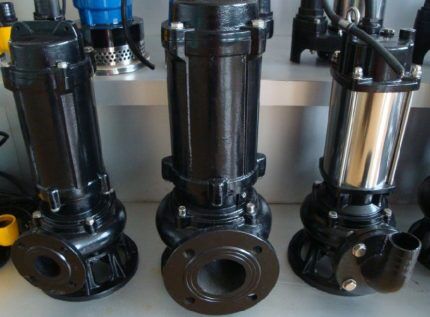
If you choose a pump with errors, then you can only use it to solve one problem. And the rest of the time it will lie in the garage, taking up space and constantly getting in the way.
Often, a fecal pump is also used to organize forced sewer system. Standard sewerage is usually designed taking into account the gravity flow of wastewater from a country house into a septic tank.
However, it is not always possible to organize such a scheme. Due to the topography of the site, the VOC or input into the centralized wastewater system existing in the village may be higher than the outlet from the house.
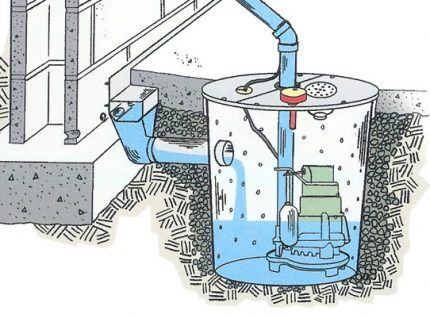
An option is also possible with the redevelopment and reconstruction of a country house, when the configuration of pipelines inside a residential building changes. But in most cases, a fecal pump is used in a dacha for pumping out cesspools, septic tanks and melt water from the basement.
Types of sewer electric pumps
Sewage pumps are divided into indoor and outdoor installations. The first models are chosen for installation near toilets and sinks.They are designed for forced pumping of wastewater through sewer pipes to a septic tank.
Such units can be designed to connect one or several plumbing fixtures at once. The second category of sewer pumps is more familiar and they are the ones most often purchased for summer cottages.
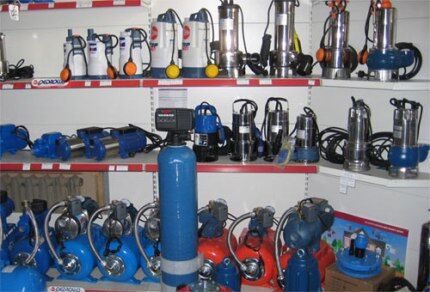
There should be a clear separation between fecal, drinking water and drainage pumps. The first ones are initially designed for grinding solid feces and small debris.
The second and third are intended for pumping water that is only clean or has fine suspended matter. If a rag or food debris gets into them, these electric pumps will simply break down.
Group #1: surface aggregates
Surface pumps for feces provide a dry installation method. To operate in automatic mode, they are mounted next to the storage manifold or in manhole. In fact, it is a small pumping station made up of several separate parts.

This type of hydraulic pumps for sewerage is the easiest to maintain and operate. At the dacha itself, it is installed next to a cesspool or drainage pit, and a hose connected to it is immersed in the fecal matter.
When choosing this pump, special attention should be paid to the maximum possible suction depth. The passport usually indicates 8–10 meters. If the hole is deeper, then this pump will not be able to lift wastewater from it.
But here it is necessary to take into account not only the size of the reservoir from which water is pumped, but also the distance from it to the pumping equipment. Each horizontal meter of hose reduces the depth capabilities of the unit by 10 cm.
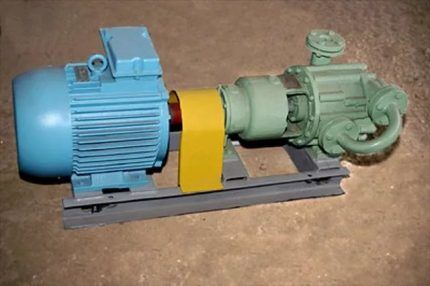
More powerful installations require a stable platform. They are mainly installed indoors, where such a platform can be easily and securely fixed to the floor.
The main disadvantage of a surface sewage pump is that it cannot operate in a damp environment. Only the suction hose can be in the water; the unit body must be on the ground and in a dry place.
It is allowed to operate such a pump only in rainy weather, and it is better to erect a small canopy for it, otherwise moisture will get inside the housing, which will inevitably lead to a short circuit.
Surface models are cheap and easy to maintain, but are quite noisy. If the pump is selected for installation in a utility room or basement, then this is the best option. But for working outside and pumping feces from a septic tank located far from a country house and buildings, it is better to purchase a submersible analogue.
Group #2: Semi-submersible kits
Semi-submersible pumping equipment consists of an electric motor installed in a dry place and a working chamber immersed in drains. They are connected into a single whole by a torque shaft.
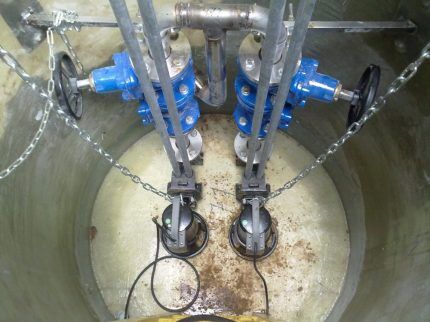
If a semi-submersible hydraulic pump is purchased for a summer residence, then it can be mounted by:
- fastenings on the wall of the drainage pit;
- installation on a platform floating on drains;
- installation in an extension next to the storage tank.
Another potential problem with the semi-submersible model is the lack of a grinder included as standard. And without it, the pump will quickly fail when pumping garbage and feces from the sewer system.
The chopper is installed additionally on such an installation, in the form of an attachment. And this increases the cost of equipment and complicates its maintenance.
Group #3: submersible hydraulic pumps
This modification of country sewage pumps involves directly immersing the entire unit in a pit with wastewater. And so that the installation does not break down in an aggressive and active sewage environment, its sealed body and all working parts are made of cast iron or stainless steel.
There are models on sale with a plastic casing, but it will not last long in the sewer. Submersible equipment for pumping feces can be used both for one-time work and in automatic mode.
In the second case, the sewage pump for the dacha should be selected with a float and automation. When the specified level of liquid in the waste tank is reached, the pumping equipment is first turned on, and then, as sewage is pumped out, it is turned off by a float device.

The presence of a float prevents the pumping equipment from running dry, which significantly prolongs its life. Submersible pumps are chosen by those who require productive and reliable equipment.
Many similar models are equipped with a built-in chopper. It stands at the input and grinds all incoming waste to a state in which it simply cannot lead to breakdown of internal mechanisms.
Compared to a surface-mounted competitor, the submersible pump is less noisy and consumes less electricity. All its power is spent on maintaining pressure in the pressure outlet pipe. It also does not have to waste energy on sucking wastewater from the bottom into the working chamber through a hose.
When a submersible unit operates, water absorbs most of the noise generated by the electric motor. But the unit is more difficult to operate and costs more than a surface model of similar power. Equipment immersed in sewage drains is initially more technologically advanced and complex than equipment left in the air.
In-house sewerage installations
Sewage pumps are also called small-sized pumping stations, which are designed to be built directly into the sewerage system inside a country house. Structurally and in terms of operating principle, such pumps resemble analogues from washing machines.
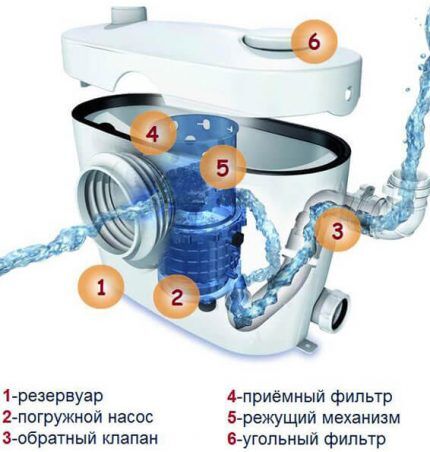
Such models of fecal pumps belong to the premium segment of plumbing and cost a lot. However, thanks to them, toilets, showers and washbasins can be installed almost anywhere in a residential building. They calmly pump wastewater even through pipelines inclined upward.
The design of this pumping station was originally based on the principle of self-cleaning.It is undemanding in terms of maintenance; it is enough to only occasionally rinse the tank from silt deposits.
It also has a carbon filter and a check valve. The first eliminates the appearance of sewer stench in the room, and the second prevents the return of waste from the sewer back to the storage tank. Fecal toilet pumps prevent blockages and ensure forced drainage of wastewater.
How should you choose a fecal pump?
The passport of a sewage pump for a summer residence contains a lot of technical characteristics. And all of them must be taken into account when choosing this technique. The first indicator is the operating temperature of the pump, i.e. waste water temperature.
Pumping equipment for sewerage can be:
- Designed to work only with cold and warm water up to +45°C.
- Designed for pumping wastewater with temperatures up to +90°C.
To pump water from the cellar and fecal sewage from the street septic tank, a first category pump is sufficient. But for uninterrupted operation as part of a forced sewer system with a lot of plumbing in a country house, you will have to select a model from the second group.
Automation, chopper and housing material
Constantly monitoring the condition of the fecal pump and controlling its operation manually means wasting your time. The dacha is always full of activities. Therefore, equipment should be immediately selected with a float and thermal relay.
The first will control the level of waste in the pumped out pit, turning the pump on/off as necessary, and the second will prevent overheating of the electric motor.
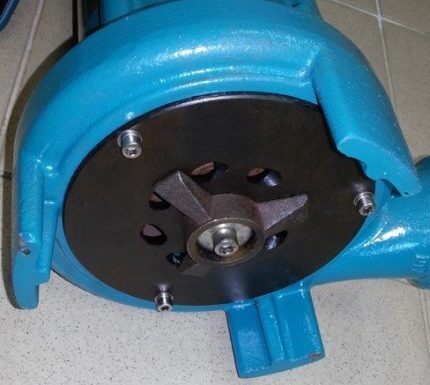
Structurally, the chopper is designed as:
- two-bladed knife;
- impellers with cutting edge;
- combined mechanism with several blades.
An impeller is the cheapest option for a chopper, but pumps with it have the lowest performance. A knife with a pair of blades located perpendicular to each other is more reliable and productive.
However, the most advanced is the combination of three cutting blades and a perforated disc. Passing through such a grinder, solid fecal fractions are transformed into a homogeneous ground mass.
Additional selection tips and the best options for fecal pumps with a grinder are presented in this article.
Based on the body material, it is best to choose a metal pump for pumping out sewage in a dacha. Stainless steel and cast iron will last many times longer than plastic. This nuance is especially important for submersible equipment, which is constantly located in aggressive, dirty water.
Lifting height, power and power supply
The higher the performance indicated in the passport, the faster the pump will pump the wastewater. However, the more electricity it will consume. A cesspool at a dacha is rarely made large, so a low-power unit is often enough to work on a dacha plot. It will pump out the sewage not in 5 minutes, but in 20, but there is no need to rush outside the city.
The optimal pump power option for a dacha is 400–500 W. This is a productivity in the region of 140–160 l/min. Such performance characteristics will make it easy to cope with pumping sewage from a drain or cesspool, and with getting rid of excess water in a country cellar.
The pressure numbers show the maximum height to which the pumping equipment through the pressure pipe is capable of lifting liquid with feces.But when calculating this indicator, it is necessary to take into account not only the vertical section of the highway, but also the horizontal one.
In addition, atmospheric pressure, material of manufacture and cross-section of pipes, as well as the temperature of the wastewater and the size of impurities in it should be taken into account.
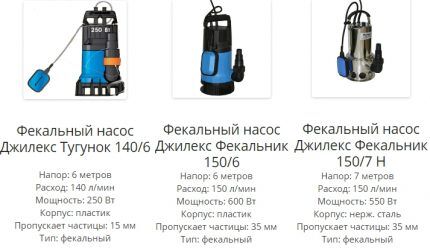
Some models of sewer pumps are designed to be powered from a single-phase network, while others are designed to be powered from a three-phase network. The first group is cheaper. As a rule, it is recommended to choose just such a fecal pump for a summer residence. It will cause fewer problems with connecting to the power grid. And if necessary, it can be powered from a portable generator.
Brief overview of manufacturers
At choosing a fecal pump It is better to give preference to models from well-known manufacturers. They specialize in this type of equipment, so their technology is always on top. And even in case of breakdowns, parts for repairing such pumps are always much easier to find.
Among the variety of brands suitable for use in the country:
- Pedrollo Vortex – “VXm” series with low power (Italy).
- Gilex – series “Fekalnik” (Russia).
- SFA – compact grinder pumps for home use (France).
- Grundfos (Denmark).
- Marina-Speroni (Italy).
- Calpeda (Italy).
- Vortex (Russia).
- Belamos (Russia).
It is worth saying that Russian pumps are in no way inferior to their imported counterparts. They were initially developed for domestic realities with voltage drops, etc.
Conclusions and useful video on the topic
The selection of the following videos will help you navigate the variety of types of fecal pumps so that you make the most correct choice of equipment for your dacha.
The operating principle of the grinder in Grundfos SEG:
How to choose a sewage pump:
Review of submersible pump with chopper:
Living in a country house outside the city, most of us do not want to give up the benefits of civilization in the form of a shower, toilet and other plumbing fixtures. But all this can only be used if there is a septic tank or cesspool at the dacha.
However, if the farm does not have an electric fecal pump to clean them, then constant calls for a sewer truck will cost a considerable amount. At the same time, your own pump can be used not only for pumping out sewage, but also for watering and getting rid of melt water in the basement in the spring.
Are you looking for an effective sewage pump for your garden? Or do you have experience using such installations? Please leave comments on the article and share your impressions of using sewage pumps.




We have been using this thing for a year now; we purchased a small fecal pump, since it is much cheaper than calling a sewer truck. We pump out sediment from the septic tank only in the warm season. But they pumped it out once in the winter, when it was warmer, after which it was washed and put in a dry place. According to technical standards, sediments must be removed at least twice a year. I advise you to definitely use a float switch so that the pump does not run dry and its motor does not burn out.
We have a submersible pump from Grundfos at our dacha. It’s been working for, it seems, five years now and I’m quite pleased with it.It is installed without dancing with a tambourine, it does not require any special maintenance. It wasn't so cheap, but it was a necessary thing, so we bought it. The pump works quietly, if you don’t specifically listen, you won’t even notice. Works stably, without failures. Useful thing.
My situation is the following - my parents have a septic tank in a private house. The septic tank is purchased, has three compartments and access to the filtration field. Once a year, according to the rules, it needs to be pumped out and cleaned. The problem is that driving a sewer truck into a septic tank is problematic - they didn’t think through it during installation. The idea came up to pump it out yourself using a fecal pump. Submersible is not suitable for me, since the septic tank pipes are 160 mm. So you need a surface pump that is capable of pumping out feces from a depth of 2.5 meters. Which one is suitable? And in such a situation, is it even possible to limit ourselves to a drainage pump?
You can use either a surface fecal pump or a drainage pump. Here it depends on your preferences, what will be more practical and profitable specifically for your case.
For example, when installing a surface pump, strict restrictions on the height of the transferred liquid must be observed. This means that you will have to determine the installation level of the system yourself. To install a drainage pump, you do not have to observe such subtleties.
But in any case, you should choose pumps with a high-quality cutting edge (chopper); in terms of price/quality ratio, I advise you to choose from the Pedrollo models.
To fully understand the operation of such pumps, I recommend watching this video https://www.youtube.com/watch?v=v2ERNsHjq-A If you have any more questions, ask them here.
We have a country house with permanent residence. The house has a shower, a toilet, a sink in the kitchen and another in the bathroom. Initially, the previous owner removed the feces and the entire drainage into a cesspool, which is located one and a half meters from the house.
These are ordinary three concrete rings. Depth approximately 2.5-3.0 meters. Can you tell me what is the best pump to install for pumping out feces? And what brand would you recommend (in terms of a budget option)? We want to pump out the area, the length of the drain hose is approximately 60-70 meters.
And will this create any inconvenience in terms of smell? We will mainly use it in winter. Vacuum trucks advised us to do this in winter. Thanks in advance for your answer.
We have a country house with permanent residence. The house has a shower, a toilet, a sink in the kitchen and another in the bathroom. Initially, the previous owner removed the feces and the entire drainage into a cesspool, which is located one and a half meters from the house.
These are ordinary three concrete rings. Depth approximately 2.5-3.0 meters. Can you tell me what is the best pump to install for pumping out feces? And what brand would you recommend (in terms of a budget option)? We want to pump out the area, the length of the drain hose is approximately 60-70 meters.
And will this create any inconvenience in terms of smell? We will mainly use it in winter. Vacuum trucks advised us to do this in winter. Thanks in advance for your answer.